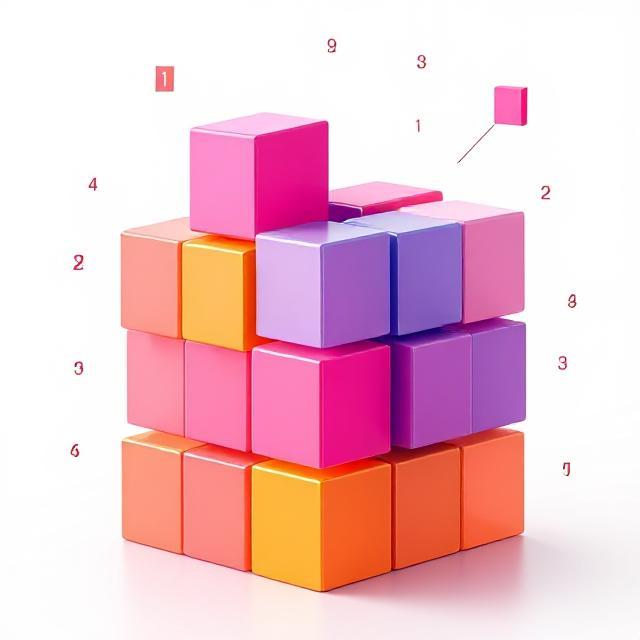Notifications

7 minutes, 24 seconds
-26 Views 0 Comments 0 Likes 0 Reviews

Cubes are more than just familiar three-dimensional shapes; they represent a cornerstone concept in mathematics that bridges arithmetic, algebra, geometry, and beyond. Whether you're calculating volume, solving equations, or exploring the nature of numbers, the concept of cubes provides foundational insight that fuels mathematical reasoning. In this blog post, we will explore the concept of cubes in mathematics, covering definitions, properties, calculations, visual interpretations, real-world applications, and educational significance. By the end, you'll have a solid grasp of why cubes are so essential in the mathematical landscape.
In mathematics, the term "cube" can refer to two main ideas:
Cube of a Number: This refers to a number raised to the power of three. It means multiplying a number by itself twice: For example, .
Geometric Cube: A three-dimensional solid object bounded by six equal square faces, with three meeting at each vertex. All angles in a cube are right angles, and all sides have equal length.
Both interpretations are deeply connected and reinforce the concept of three-dimensionality in mathematics.
Cubing numbers is an essential arithmetic operation with widespread applications. Let’s examine some key elements:
Perfect cubes are numbers that are the cube of an integer.
These values form a useful list for mental math and estimation.
Cubes appear in several important algebraic identities:
These identities help in factoring expressions and solving higher-degree equations.
The cube function is a nonlinear function that passes through the origin. It is odd and symmetric about the origin, with a steep curve and increasing slope. This function is continuous and differentiable everywhere, a key feature in calculus.
From a geometric perspective, cubes are regular polyhedra and one of the five Platonic solids. They are characterized by several distinct features:
6 equal square faces
12 equal edges
8 vertices
All internal angles are right angles
The volume of a cube is calculated as: where is the length of a side.
The surface area is:
These formulas are foundational in geometry and are used extensively in real-world applications.
Architecture: Cubic shapes are used in structural design due to their strength and symmetry.
Packaging: Boxes and containers are often cube-shaped for efficient stacking and storage.
Engineering: Cube volume calculations help in determining material requirements.
To understand cubes deeply, it's essential to also grasp their inverse: the cube root. The cube root of a number is the number
Cube roots appear in equations, volume problems, and even in complex number analysis.
Cubes follow fascinating numerical patterns that make them easy to identify and work with:
Last Digits of Cubes:
The units digit of cubes shows repeating patterns. For instance, the cube of any number ending in 2 ends in 8.
Sum of First n Cubes:
A beautiful identity: This identity shows a deep connection between squares and cubes.
Difference Between Cubes:
The difference between successive cubes grows quickly: , , etc.
Cubes aren’t just for early math learners. They show up throughout more advanced topics:
Number Theory:
Fermat’s Last Theorem, which states that has no integer solutions for , directly relates to cubes when .
Algebraic Geometry:
Cubic equations define cubic curves, which are fundamental in the study of elliptic curves and cryptography.
Linear Algebra:
Determinants of 3x3 matrices relate geometrically to the volume of a cube or parallelepiped in 3D space.
Calculus:
Derivatives and integrals of cube functions offer practice in power rule applications.
Cubes help build foundational mathematical skills across various levels of education:
Primary School: Introduction to multiplication and volume.
Middle School: Understanding exponents and spatial reasoning.
High School: Working with algebraic identities and solving cubic equations.
College and Beyond: Engaging with complex analysis and geometric modeling.
Teaching strategies include:
Hands-on cube building with blocks
Volume experiments using water or sand
Graphing and its transformations
These activities foster a tangible understanding of what cubes represent.
Cubes are more than academic abstractions. They play an integral role in many fields:
Computer Science: Cubic algorithms and 3D modeling depend on cube-based calculations.
Game Design: Voxel-based games like Minecraft rely heavily on cube representation.
Data Science: Cube notation is used in OLAP (Online Analytical Processing) to represent multidimensional datasets.
Art and Architecture: Cubic motifs influence visual aesthetics and structural stability.
Rubik’s Cube: A world-famous puzzle that demonstrates symmetry, logic, and the power of permutation.
Magic Cubes: 3D analogs of magic squares where the sums of numbers on each line are equal.
Cube Puzzles and Mazes: Educational tools that enhance spatial and mathematical reasoning.
Cubes in math are not only practical but also deeply enriching. Whether as numbers raised to the third power or as geometric figures in three dimensions, cubes link together multiple branches of mathematics. They offer insight into the physical world, open the door to complex problem solving, and form the foundation for advanced study.
Understanding cubes equips students and professionals alike with a powerful tool for reasoning about size, shape, structure, and growth. As both an abstract idea and a concrete form, the cube truly earns its place as a mathematical cornerstone.

